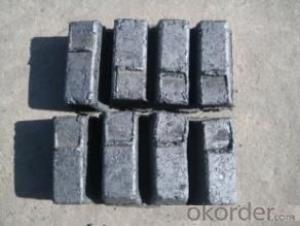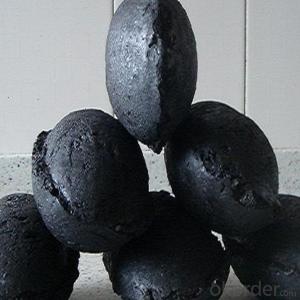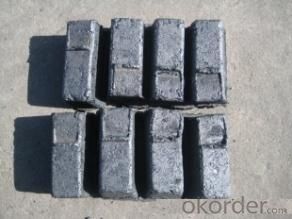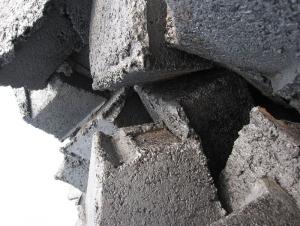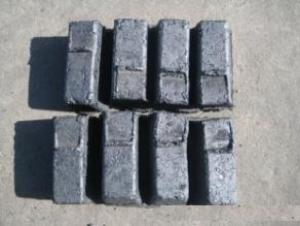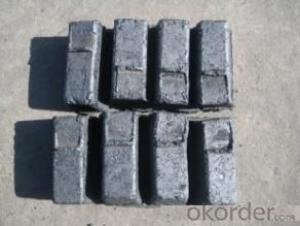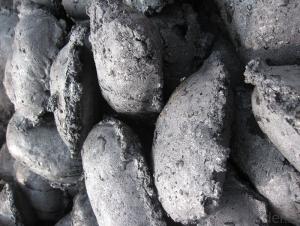Carbon Electrode Paste with high quality
- Loading Port:
- Lianyungang
- Payment Terms:
- TT OR LC
- Min Order Qty:
- 20 m.t.
- Supply Capability:
- 800 m.t./month
OKorder Service Pledge
OKorder Financial Service
You Might Also Like
Spcifications
1:carbon eletrode paste
2:for ferroalloy,calcium carbide manufacture
3:HS 3801300000,YB/T5212-1996,ISO9001:2008
Product Description
Carbon Electrode Paste is a self-baking electrode used in submerged arc furnaces for delivering power to the charge mix. Electrode Paste is added to the top of the electrode column in either cylindrical or briquette form. As the paste moves down the electrode column the temperature increase causes the paste to melt and subsequently bake forming a block of electrically conductive carbon. Electrode Paste is essentially a mix of Electrically Calcined Anthracite (ECA) or Calcined Petroleum Coke (CPC) with Coal Tar Pitch.
Graphite/Carbon Electrode Paste Specification:
| PARAMETER UNIT GUARANTEE VALUE | ||||||
| Ash.( % ) | 4.0 max | 5.0 max | 6.0 max | 7.0 max | 9.0 max | 11.0 max |
| V.M (%) | 12.0-15.5 | 12.0-15.5 | 12.0-15.5 | 9.5-13.5 | 11.5-15.5 | 11.5-15.5 |
| Compress Strength. | 18.0 min | 17.0 min | 15.7 min | 19.6 min | 19.6 min | 19.6 min |
| Specific Resistance | 65 max | 68 max | 75 max | 80 max | 90 max | 90 max |
| Bulk Density | 1.38 min | 1.38 min | 1.38 min | 1.38 min | 1.38 min | 1.38 min |
Picture:

- Q: How does carbon contribute to the structure of DNA?
- Carbon is an essential element in the structure of DNA as it forms the backbone of the molecule. Carbon atoms in the sugar-phosphate backbone of DNA provide stability and flexibility, allowing the molecule to twist and fold into its double helix shape. Additionally, carbon atoms are also present in the nitrogenous bases, which are the building blocks of the genetic code. Overall, carbon's presence in DNA is crucial for its overall structure and function in storing and transmitting genetic information.
- Q: How does carbon affect water quality?
- Water quality can be affected both positively and negatively by carbon. On the positive side, carbon is a natural component of the carbon cycle and has a vital role in maintaining the equilibrium of aquatic ecosystems. It serves as a nutrient for aquatic plants, aiding their growth and providing nourishment and shelter for other organisms in the food chain. However, an excess of carbon in water can have adverse effects on water quality. One way this occurs is through the rise of dissolved organic carbon (DOC). Elevated levels of DOC can result from the decomposition of organic matter, such as deceased plants and animals, as well as the leaching of organic compounds from soil. These organic compounds can harm water quality by diminishing the amount of dissolved oxygen accessible to aquatic organisms, leading to asphyxiation of fish and other aquatic life. Moreover, high levels of carbon can contribute to eutrophication. Eutrophication takes place when there is an overflow of nutrients, including carbon, in water bodies, causing an excessive growth of algae and other aquatic plants. This excessive growth can deplete oxygen levels in the water as the plants decompose, causing harm to fish and other organisms that rely on oxygen for survival. Additionally, carbon can interact with other pollutants present in water, like heavy metals and pesticides, which can become more toxic and readily available when combined with carbon. This can have detrimental effects on aquatic organisms and disrupt the overall balance of the ecosystem. In conclusion, while carbon is vital for the functioning of aquatic ecosystems, excessive amounts can negatively impact water quality by reducing oxygen levels, promoting eutrophication, and increasing the toxicity of other pollutants. Therefore, it is crucial to monitor and manage carbon levels in water bodies to ensure the maintenance of a healthy and balanced aquatic ecosystem.
- Q: What are the industrial uses of diamonds?
- Diamonds have a wide range of industrial uses due to their exceptional physical properties. One of the most common industrial uses of diamonds is in the manufacturing of cutting and grinding tools. Diamond-tipped saw blades, drill bits, and grinding wheels are highly sought after for their superior hardness and abrasion resistance. These tools are used to cut and shape hard materials like concrete, ceramics, and metals. Diamonds also find extensive applications in the electronics industry. They are used as heat sinks in high-power electronic devices and as abrasive materials for polishing and lapping electronic components. The thermal conductivity of diamonds allows them to efficiently dissipate heat, making them ideal for electronic devices that generate a lot of heat during operation. Furthermore, diamonds are used in the production of specialized windows, lenses, and prisms for various scientific and industrial applications. Their optical properties, such as high refractive index and low dispersion, make them valuable for creating precision optics used in lasers, spectroscopy, and telecommunications. In addition, diamonds have found niche uses in the medical and dental fields. They are used in surgical tools such as scalpels and dental drills due to their exceptional hardness and ability to retain sharp edges. Diamond coatings are also applied to medical implants and prosthetics to improve their wear resistance and biocompatibility. Lastly, diamonds are utilized in the oil and gas industry for drilling and exploration purposes. Diamond drill bits are capable of penetrating extremely hard rock formations, making them essential for extracting oil and natural gas from deep beneath the Earth's surface. Overall, the industrial uses of diamonds are vast and diverse, ranging from cutting and grinding tools to electronics, optics, medicine, and even oil and gas exploration. The unique properties of diamonds make them indispensable in numerous industrial applications, contributing to advancements in various fields.
- Q: What are the different types of carbon steel?
- Carbon steel is a versatile and widely used material in various industries due to its strength, durability, and affordability. There are several different types of carbon steel, each with its own unique properties and applications. 1. Low Carbon Steel: This type of carbon steel contains a low amount of carbon, typically up to 0.25%. It is the most commonly used form of carbon steel due to its ease of fabrication, weldability, and affordability. Low carbon steel is used in applications such as construction, automotive manufacturing, and general engineering. 2. Medium Carbon Steel: With a carbon content ranging between 0.25% and 0.60%, medium carbon steel offers increased strength and hardness compared to low carbon steel. It is commonly used in machinery parts, axles, gears, and shafts that require higher levels of toughness and wear resistance. 3. High Carbon Steel: High carbon steel contains a carbon content of 0.60% to 1.00%. It has excellent strength and hardness but is less ductile and more brittle compared to low and medium carbon steels. High carbon steel is commonly used in applications such as cutting tools, springs, and high-strength wires. 4. Ultra-High Carbon Steel: This type of carbon steel contains a carbon content greater than 1.00%, typically ranging from 1.20% to 2.50%. It possesses extremely high hardness and is often used in specialized applications such as knives, blades, and tools that require exceptional sharpness and wear resistance. 5. Carbon Tool Steel: Carbon tool steel refers to a group of steels that contain additional alloying elements such as chromium, vanadium, or tungsten. These alloying elements enhance the steel's hardness, wear resistance, and heat resistance, making it suitable for tool and die making, cutting tools, and molds. It is important to note that the carbon content of steel determines its strength, hardness, and other properties. The choice of carbon steel type depends on the specific application, desired characteristics, and manufacturing requirements.
- Q: Often see the so-called 30T, 46T, 60T carbon fiber, 60T carbon fiber, equivalent to T hundreds of carbon fibers, is T800, or T1000? I'm not very good at parameter conversion. Is there a parameter list? How do I correspond to the T300T700T800 performance parameter table?
- Two, 46T, 60T refers to high modulus carbon fibers. M series; T1000 refers to the high strength carbon fiber, belonging to the T series; M series and T series belong to different performance products.
- Q: What is the symbol for carbon?
- The symbol for carbon is "C".
- Q: Carbon content of fly ash and fly ash roasted vector what is the relationship?
- The loss of coal ash is mainly caused by the incomplete combustion of coal, the remaining carbon is introduced, and the carbon content is high, then the amount of burning is high. From the color, it can be clearly seen that the black fly ash has high carbon content and high ignition loss. Based on the molecular weights of C and CO2, a preliminary estimate is made.
- Q: What's the difference between an alkaline cell and a carbon cell?
- Alkaline batteries, also known as alkaline dry cells, alkaline manganese dioxide batteries and alkaline manganese batteries, are among the best in the range of zinc manganese batteries. The utility model is suitable for large discharge capacity and long time use. The internal resistance of the battery is low, so the current produced is larger than that of the general manganese battery, while the environmental friendly mercury content is only 0.025%. A carbon cell belongs to a primary battery in a chemical power supply and is a disposable battery. Because the chemical power unit has an electrolyte that is a non flowing paste, it is also called a dry cell, as opposed to a battery with a flowing electrolyte. Carbon battery is not only suitable for the flashlight, radios, tape recorders, cameras, semiconductor, electronic clocks, toys and other fields, but also for national defense, scientific research, telecommunication, navigation, aviation, medicine, etc. in the national economy.
- Q: What is the concept of carbon neutrality?
- Carbon neutrality is the idea that an entity, whether it be an individual, organization, or even a whole country, has achieved a balance between the amount of carbon dioxide emissions they produce and the amount they offset or remove from the atmosphere. It is essentially a state where the net carbon emissions are zero, indicating that the entity is not contributing to the increase in greenhouse gases and climate change. Achieving carbon neutrality often involves reducing emissions through sustainable practices and technologies, as well as investing in carbon offset projects or utilizing carbon capture and storage methods.
- Q: What does carbon burning mean?
- Put the burning carbon under the iron plate and make a copy of it on the iron plate, that is, carbon burning!
Send your message to us
Carbon Electrode Paste with high quality
- Loading Port:
- Lianyungang
- Payment Terms:
- TT OR LC
- Min Order Qty:
- 20 m.t.
- Supply Capability:
- 800 m.t./month
OKorder Service Pledge
OKorder Financial Service
Similar products
Hot products
Hot Searches
